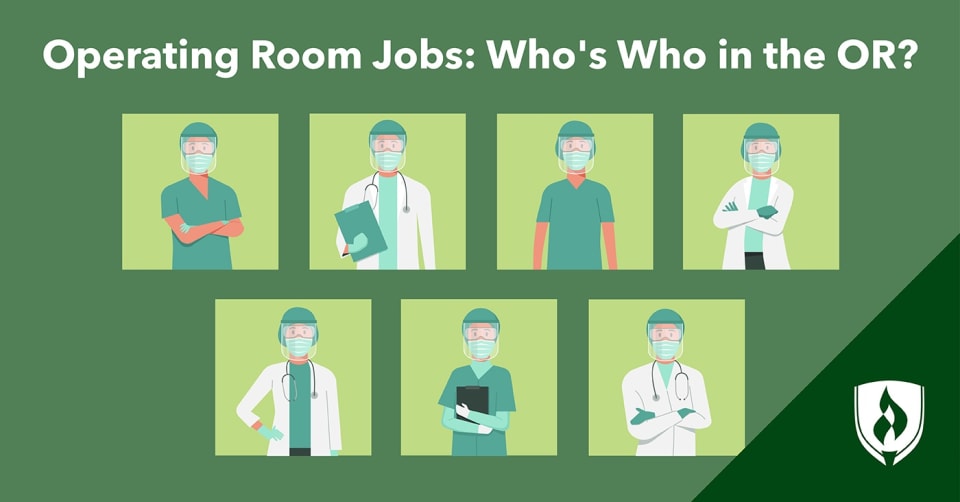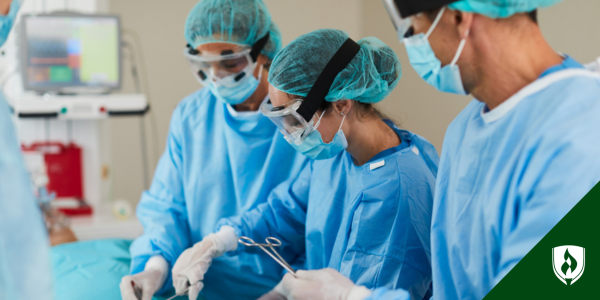
Operating rooms (ORs) can seem mysterious to those of us who, like most patients, have never been conscious inside of one. Patients generally spend most of their time sedated, and any memories they have from the OR may be cloudy at best.
Often, when you do see these healthcare professionals in photos or on surgical TV shows, they’re usually donning personal protective equipment (PPE)—surgical scrubs, masks, scrub caps, surgical gowns, gloves and eyewear—that add a (literal) extra layer of cover. Given how out of sight these folks are for the average patient, it’s understandable if you’re a little unsure of who’s who in the operating room. In this article, we’ll unmask the many professionals you’ll find in the OR.
Whether you’re just generally curious about surgery or seriously considering a career in healthcare, you’re in the right place. We’re taking a closer look at the different types of healthcare professionals you’ll find in or around the operating room on a daily basis.
1. Anesthesiologist
Anesthesiologists are Medical Doctors or Doctors of Osteopathic Medicine who are responsible for administering anesthesia—a combination of pain medicine, sedatives and paralytic drugs—that keep patients from waking up or feeling pain during the operation.
Different operations require different levels of sedation, and each person responds to the medication differently, so anesthesiologists must be highly trained and sensitive to any changes in the patient’s vitals.
What they do: Anesthesiologists meet the patient before surgery to evaluate their health and screen for any issues that may change their plan for anesthesia. They answer any questions the patients have and do their best to ease any concerns. During the operation, they are in charge of carefully watching the patient’s vitals, breathing and body-fluid levels. They also control the patient’s pain levels and level of consciousness. After surgery, patients are usually cared for in the Post-Anesthesia Care Unit (PACU) or ICU (Intensive Care Unit), where an anesthesia team ensures the patient wakes up safely.
Anesthesiologists often oversee other anesthesiology team members, like anesthesiologist assistants (AAs), certified registered nurse anesthetists (CRNAs), anesthesia technologists or anesthesia technicians.
Education: Anesthesiologists need extensive training, including a Bachelor’s degree, four years of medical school or osteopathic medicine and a four-year residency in anesthesia. Many also do a one-year fellowship to specialize further in areas like pain management, cardiac anesthesia, pediatric anesthesia, neuroanesthesia, obstetric anesthesia or critical care medicine.
2. Anesthesiologist Assistant (CAA)
Certified anesthesiologist assistants (CAAs) are non-physician anesthetists. They work under anesthesiologists but can function independently in the OR—providing anesthesia, maintaining the patient’s airway and keeping a close eye on the patient’s vitals. Their supervising anesthesiologist must be available at the healthcare facility to check-in or handle any emergencies.
What they do: Under the medical direction of anesthesiologists, anesthesiologist assistants conduct pre-op patient evaluations, make an anesthesia plan, administer anesthetic and pain medications, observe patient vitals, and respond to life-threatening situations during surgery if needed. After surgery, they’ll also do post-anesthesia patient rounds and write reports. Typically, if an anesthesia assistant is administering anesthesia, they will remain in the OR the entire time, and the anesthesiologists will check in with them as the surgery progresses and will intervene if needed.
Education: An anesthesiologist assistant typically needs a Bachelor’s degree with a premed track. Master’s degree programs for anesthesiologist assistants typically require a certain undergraduate level science courses and usually some healthcare experience. Once they earn a Master of Science in Anesthesiology degree, they take a certification exam to become earn the CAA credential.
3. Anesthesia technician
Even though anesthesia technicians cannot administer anesthesia, they are important members of the anesthesia team. Anesthesia technicians work with nurse anesthetists, anesthesiologists and anesthesia assistants to ensure all anesthesia equipment and medications are stocked and ready to go in every operating room and every anesthesia cart that is used in other areas of the hospital.
What they do: Anesthesia technicians evaluate and stock anesthesia supplies in the operating room prior to surgeries. They also make sure the equipment and machines are maintained and working as expected. They can also help transport patients to and from the operating room.
Education: In most states and hospitals, anesthesia technicians do not need certification. Earning a high school diploma and taking a course in medical terminology is a good place to start.
4. Anesthesia technologist
Though the anesthesia technologist role is very similar to the role of anesthesia technician, technologists usually have additional responsibilities in the OR—and often additional training and education.
What they do: In addition to stocking anesthesia equipment and medicines, technologists may also be tasked with monitoring a patient’s vital signs while they are under anesthesia and alerting the anesthesiologists to changes in the patient’s condition.
Education: Anesthesia technologists normally need a postsecondary certification or an Associate’s degree to become a Certified Anesthesia Technologist (Cer.A.T.T.). This certification may be required by an employer, but it is currently not required by any states.
5. Cardiac perfusionist
Cardiac perfusionists can go by many names, including perfusion technologists, certified clinical perfusionists or cardiopulmonary perfusionists. No matter what name a specific hospital uses, it’s certain that perfusionists play a unique role in the OR. Perfusionists are present for surgeries that require the use of the heart-lung machine, also called a bypass machine. This includes open-heart procedures and other medical procedures in which it is necessary to artificially support or temporarily replace a patient's circulatory or respiratory function.
What they do: Before surgery, perfusionists study the patient’s medical history to look for any issues that might complicate the use of the heart-lung machine. During operations, perfusionists operate the heart-lung machine and any ventricular-assist devices. They are constantly watching the patient’s vitals, including arterial blood-gas levels, to ensure the patient is getting the right amount of oxygen. They can also administer blood products and routine medications to patients during surgery.
Education: Cardiac perfusionists need advanced training in both the medical and technological aspects of their jobs. First, they need a Bachelor’s degree that includes several undergraduate science and math courses. Then, they must be accepted in an Accredited Perfusion Technology or Extracorporeal Technology program. These can be a one-year certificate program or a two-year Master’s program. After graduation, cardiac perfusionists obtain certification through the American Board of Cardiovascular Perfusion to become certified clinical perfusionists (CCPs).
6. Nurse anesthetist (CRNA)
Nurse anesthetists, like anesthesia assistants, are non-physician anesthetists. That means that they can administer anesthesia, assess patient response and educate patients under the supervision of an anesthesiologists.
What they do: Like anesthesia assistants and anesthesiologists, nurse anesthetists create an anesthesia plan, conduct a pre-op evaluation on the patient, identify risk factors, administer anesthesia, perform nerve blocks, monitor the patient through the surgery and follow-up with the patient in the PACU.
Education: The differences between anesthesia assistants and nurse anesthetists mostly lie in how they are trained and certified. Nurse anesthetists are registered nurses (RNs) with their Bachelor of Science in Nursing degrees. After they gain experience as RNs, usually in a critical-care setting, nurses can begin applying for a Master’s or Doctorate degree in a nurse anesthesia program. After graduating, they pursue certification and state licensure.
7. OR registered nurse
RNs in the OR can play a variety of roles. Though they also work in preoperative and postoperative roles, we’ll be focusing on the RNs in the OR, also called perioperative nurses or surgical nurses.
What they do: There are three primary roles for nurses in the OR:
- Scrub nurse: Selects and handles instruments and other supplies
- Circulating nurse: Manages the overall environment in the operating room to keep everyone safe and comfortable. Works outside of the sterile field
- RN first assistants (RNFA): Performs direct surgical duties, like retracting, closing incisions and controlling bleeding
Education: Surgical nurses must be registered nurses. To become a registered nurse, candidates must first complete an Associate’s Degree in Nursing (ADN) or a Bachelor of Science in Nursing (BSN) and then meet any state licensure requirements.
8. Surgeon
Surgeons are doctors who are licensed to perform surgery—usually general surgery or a specific specialty.
What they do: Surgeons perform the surgical procedure by using their well-tuned fine motor skills and deep medical knowledge. They can investigate disease, remove or repair damaged tissue, or make improvements to the function of an organ or structure.
Education: As you might expect, surgeons need a lot of education and training, including a Bachelor’s degree with required science prerequisites before entering medical school to become a Medical Doctor (MD) or Doctor of Osteopathic Medicine (DO). After medical school, surgeons will enter a three-to-seven-year residency. An additional fellowship is often necessary to perform specialty surgeries.
9. Surgical first assistant
Surgical first assistants work closely with surgeons and perform direct surgical care, like holding open incisions, stopping bleeding and closing incisions. They are also called “first assists” or “surgical assistants.” First assistants can be certified surgical first assistants, nurse practitioners, physician assistants or registered nurse first assistants.
What they do: Surgical first assistant duties are mostly contained in the operating room. Before surgery, they’ll help position and drape the patient for surgery. During the surgery, they’ll assist the surgeon by holding open incisions with retractors and help control bleeding with suction, clamping, cauterizing or suturing. After the surgeon is done, they’ll ensure all sponges and surgical tools are accounted for and close the incision.
These duties can change depending on the specific surgery being performed and the healthcare facility. Additionally, duties may vary depending on whether the first assist is a physician assistant or nurse practitioner.
Education: Surgical first assistants are highly skilled healthcare professionals, so their training and education backgrounds reflect this. Typically, surgical first assistants complete a Bachelor’s degree and then complete a training program that lasts one to two years. Additionally, there are pathways for licensed healthcare providers, like doctors, physician assistants and nurse practitioners, to become surgical first assistants.
10. Surgical technologist
Surgical technologists are vital team members in the OR. They primarily oversee the surgical tools needed for a given procedure.
What they do: Before the surgery begins, surgical technologists prepare the operating rooms, which includes sterilizing equipment, disinfecting incision sites on the patient and testing equipment. During surgery, they’ll pass supplies to the surgeon as needed, observe the OR conditions throughout the procedure to ensure the sterile field is clear and observe the patient’s vital signs. After the surgery, they’ll make sure all the tools are accounted for, transport the patient to recovery and make sure the equipment is sterilized.
Education: Surgical technologists need either a diploma, certificate or an Associate’s degree from a Surgical Technologist program. After graduation, they typically pursue certification, like the Certified Surgical Technologist (CST) credential.1
Find your place in the OR
Though operating rooms aren’t very big, if you’re intrigued by surgery, chances are good there’s a place for you there. As you can tell, there are many roles to choose from. To get a more detailed view of what your day-to-day could look like as a surgical technologist, check out our article “Surgical Technologist Duties: A Day in the Life.”
Related Articles:
1At Rasmussen University, graduation from a campus with programmatic accreditation is a requirement to sit for the Certified Surgical Technologist (“CST”) certification through the National Board of Surgical Technology and Surgical Assisting (NBSTSA). The CST certification may be required for state professional licensure or certification. Other eligibility requirements may apply to state and national licenses and certifications; please verify your eligibility against applicable rules, which may change at any time.




